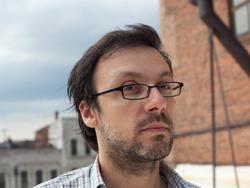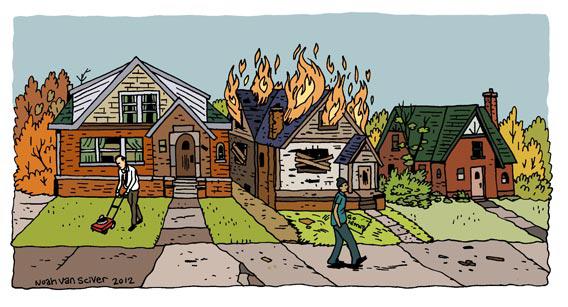I didn’t think there was more to be said about Detroit. I didn’t think Detroit City Is the Place To Be, Mark Binelli’s book about the city, needed to exist. As a non-native observer of the city—I was born in Michigan but never lived in or near Detroit—I’d gone through a seemingly conclusive series of Detroit attitudes that I imagine many other outsiders have also experienced:
- treating it as a punch line the way you might reference New Jersey; then
- realizing with fascination that it is not just in bad shape, but in really spectacularly, surreally, sublimely bad shape, such that it makes pre-Sandy New Jersey look like 1920s Paris; then
- feeling ashamed because becoming a connoisseur of the kind of Detroit disaster areas photographed so often they’re now referred to as “ruin porn” is to be missing the point in a massive, insensitive way about a huge collective societal fuck-up that we should all feel appalled by and at least somewhat responsible for; then
- trying to take heart in stories about the city’s culture- and tech- and spirit-of-baseball-driven revivals; then
- facing the fact that fun restaurants and a good baseball team and a few 50-person startup offices here and there aren’t really going to do it for a city that has 20 percent unemployment; then …
…well, there is no then then. That’s it. Detroit just remains an unhappy place. (Although maybe there’s a sixth stage: realizing morosely that you could substitute about 30 American locations—Gary, Ind.; Baltimore, New Jersey—for “Detroit” in that previous paragraph and not have to change any of the other details.) Having been let down before, we’ve learned not to bite when someone suggests the city could rise from the rubble, and yet, probably out of deference more to the natural patterns of the human brain—the need to answer a question once it’s posed—than conviction, Detroit stories still almost always end with prescriptive suggestions about the way forward. And this sense that the writer knows what could be done inevitably rings false—if not immediately, then at the next Census or unemployment report or political scandal that sounds like dementedly brilliant fiction.
If consideration of Detroit doesn’t end with hope, it probably ends with dismissal: “Well, those people made their bed, and they can lie in it.” That’s not something a lot of people would write publicly about Detroit, but it is certainly something a lot of people think. (I’ve thought it at times.) But that—even though many of the decisions made in Detroit were terrible—also seems a too-convenient way to close consideration of the issue. It’s letting yourself off the hook. I think of the city as a Buddhist challenge to the modern citizen. (Note: I know almost nothing about Buddhism.) The story of Detroit cannot be avoided dramatically or morally, but it has no ending.
As a writer, that might’ve stopped me, but it doesn’t stop Binelli. And fortunately, Binelli is a good storyteller, an entertaining historian, and an insightful commenter who is comfortable completely failing the requirements of the genres he’s working in. His stories don’t have a lesson; his history uncovers no new themes; his analysis does not lead to a constructive conclusion. Maybe he’s one of those Buddhist fellows. In his book, Binelli, who grew up in a blue-collar Detroit suburb, moves to the city after years in New York. He learns about the city’s past and present and floats around visiting various civic figures and meeting people by happenstance. Then the book ends. After that, at least according his bio on the book flap, he left. He didn’t have a crisis of conscience or an epiphany. He didn’t have his faith in something renewed and decide to stay forever, and he didn’t ultimately lose his shit and declare that the brutes must be exterminated. Binelli went to Detroit and lived there.
Does that sound boring? It’s not. Because while Detroit may have been in unpleasant stasis for 30 years, it is a strange, compelling stasis that traditional accounts and short visits to the city—however well-intentioned—almost never crack. If you are looking for new insight about Detroit as a whole, you are not going to find it here (though are you going to have everything we do know summarized in entertaining fashion). You are going to find out something about what kind of person sticks it out in a city going nowhere.
The answer, shockingly: a person like you. Few of Binelli’s subjects are bohemian transplants or high-level hustlers. (He doesn’t ignore the worlds of young-white-kid culture or political maneuvering, but he treats them as marginal, with a sardonic distance that seems appropriate.) Many are just regular ol’ folks, and he has a knack for relating to and portraying even the prominent ones—a principal at a successful school for pregnant teens, an underemployed “heavy-equipment operator” who started an oft-written-about farm on some empty urban land—such that they come across less like totems of hope or models of visionary thinking than as normal people, admirable, but capable of normal-person weariness and doubt. His interview with the principal is interrupted by a call about an opossum living in the wall of her house. The farmer notes wryly that if more land was used for what he was doing, “there’d be less dope houses,” though “maybe there’d be more meth labs.”

Author Mark Binelli
Photo by Corine Vermeulen
My favorite section is about the firefighters of Highland Park, an independent municipality that for arcane reasons is located within the city itself. The firefighters are stuck using utterly horrendous equipment and facilities to put out an utterly horrendous barrage of fires, many of them suspected arsons. (“One firefighter from the Bronx visited twice every year,” Binelli writes. “He’d told the Highland Park guys the Bronx had become boring: most of their buildings were occupied now, and it just wasn’t popping like in the old days.”) And yet, being a firefighter in Highland Park sounds …OK. I mean, you’d certainly have to be willing to be constantly exhausted and disappointed. But the group has its moments of camaraderie in the clubby headquarters it’s improvised inside a warehouse. They solve problems. They do a job. They are not the hollow-eyed prisoners of war one might picture. Why do they get up in the morning and go to work? I don’t know—why do you get up in the morning and go to work?
These little biographies, the vignettes of small challenges met and unmet (his account of a Pyrrhic UAW grievance victory makes a great short story) are, actually, a sly form of political rhetoric. Because if what you know of Detroit are villains and heroes—rapacious auto executives and craven, corrupt politicians, daring urban homesteaders and innovative urbanists, gangster thugs and inspirational basketball coaches and saintly old women mourning their children—then it becomes easy to shut yourself off from the city. As in: Screw it, this is a battle for Other People, those who are braver and smarter than us, and people who are fucked beyond redemption. People willing to get mugged 12 times a day for their ideals vs. the self-abased losers who would rather watch TV than have windows on their house. One could be forgiven, even after having visited the city—perhaps especially after having experienced its bizarreness in person, when you’re inclined naturally to notice the extremes—for thinking that these are the only people left in Detroit.
But, as Binelli makes clear, they are not. Detroit actually has a silent majority of normalness. Their heroic acts of resilience consist of weary obligations like mowing the lawn. Truly: For a lot of the people in Binelli’s book, mowing the lawn—and also the lawn in the vacant lot where their neighbor would live if their neighbor hadn’t lost their job, died, and had their house burned down by a crackhead who dropped his crack pipe while looking for scrap copper to sell to buy crack—is a statement. They don’t need to be left for dead or have their entire way of life revolutionized. They just need the same help that the rest of our country needs.
What will happen to them? We don’t know the answer yet. We probably won’t realize what saved or killed Detroit, Gary, Baltimore, or, really, America, until it’s already happened. Can you live with that? The lawn-mowing men and women of Detroit can. There’s nothing new to be said about their city. Let’s keep saying it.
—
Detroit City Is the Place to Be: The Afterlife of an American Metropolis by Mark Binelli. Metropolitan Books.
See all the pieces in this month’s Slate Book Review.
Sign up for the Slate Book Review monthly newsletter.
